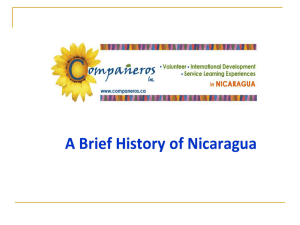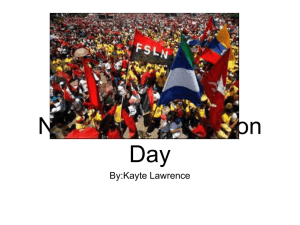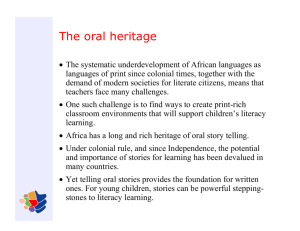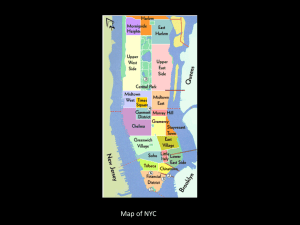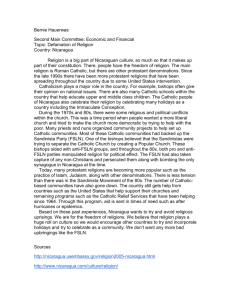Memory of the World Register - National Literacy
advertisement
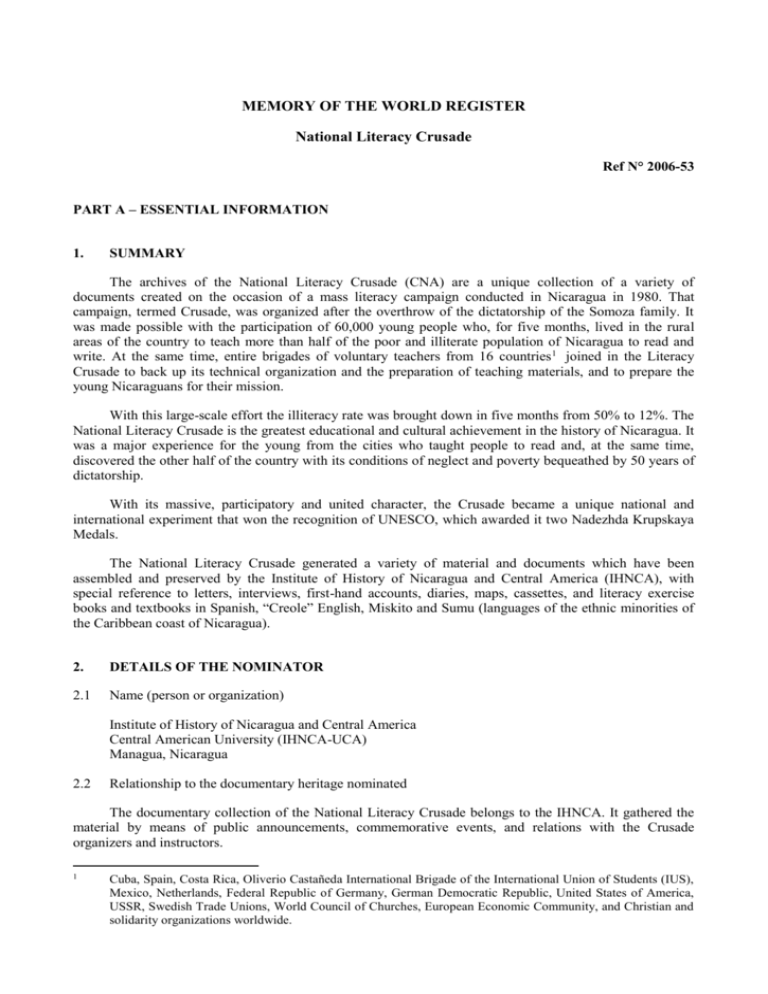
MEMORY OF THE WORLD REGISTER National Literacy Crusade Ref N° 2006-53 PART A – ESSENTIAL INFORMATION 1. SUMMARY The archives of the National Literacy Crusade (CNA) are a unique collection of a variety of documents created on the occasion of a mass literacy campaign conducted in Nicaragua in 1980. That campaign, termed Crusade, was organized after the overthrow of the dictatorship of the Somoza family. It was made possible with the participation of 60,000 young people who, for five months, lived in the rural areas of the country to teach more than half of the poor and illiterate population of Nicaragua to read and write. At the same time, entire brigades of voluntary teachers from 16 countries 1 joined in the Literacy Crusade to back up its technical organization and the preparation of teaching materials, and to prepare the young Nicaraguans for their mission. With this large-scale effort the illiteracy rate was brought down in five months from 50% to 12%. The National Literacy Crusade is the greatest educational and cultural achievement in the history of Nicaragua. It was a major experience for the young from the cities who taught people to read and, at the same time, discovered the other half of the country with its conditions of neglect and poverty bequeathed by 50 years of dictatorship. With its massive, participatory and united character, the Crusade became a unique national and international experiment that won the recognition of UNESCO, which awarded it two Nadezhda Krupskaya Medals. The National Literacy Crusade generated a variety of material and documents which have been assembled and preserved by the Institute of History of Nicaragua and Central America (IHNCA), with special reference to letters, interviews, first-hand accounts, diaries, maps, cassettes, and literacy exercise books and textbooks in Spanish, “Creole” English, Miskito and Sumu (languages of the ethnic minorities of the Caribbean coast of Nicaragua). 2. DETAILS OF THE NOMINATOR 2.1 Name (person or organization) Institute of History of Nicaragua and Central America Central American University (IHNCA-UCA) Managua, Nicaragua 2.2 Relationship to the documentary heritage nominated The documentary collection of the National Literacy Crusade belongs to the IHNCA. It gathered the material by means of public announcements, commemorative events, and relations with the Crusade organizers and instructors. 1 Cuba, Spain, Costa Rica, Oliverio Castañeda International Brigade of the International Union of Students (IUS), Mexico, Netherlands, Federal Republic of Germany, German Democratic Republic, United States of America, USSR, Swedish Trade Unions, World Council of Churches, European Economic Community, and Christian and solidarity organizations worldwide. -2Furthermore, in 1980 the IHNCA set up jointly with the Crusade an oral history project to gather the testimony of popular leaders of Nicaragua’s rural and semi-rural communities regarding the people’s struggle against the Somoza dictatorship. The interviews were recorded by the literacy instructors, which gave rise to a highly important collection of sound cassettes and diaries. The cassettes are kept in the IHNCA history archives. 2.3 Contact person(s) Maria de los Ángeles Chirino Ramos Director, History Archives, IHNCA-UCA 2.4 Contact details (include address, phone, fax, email) Instituto de Historia de Nicaragua y Centroamérica – IHNCA Universidad Centroamericana – UCA Rotonda Rubén Darío 200 metros al oeste Managua, Nicaragua Tel.: (505) 2787317, 2787342 Fax: (505) 2787324 Email: ihn@ns.uca.edu.ni 3. IDENTITY AND DESCRIPTION OF THE DOCUMENTARY HERITAGE 3.1 Name and identification details of the items being nominated National Literacy Crusade, from 24 March to 23 August 1980 Institute of History of Nicaragua and Central America Central American University (IHNCA-UCA) Managua, Nicaragua 3.2 Description Attach a description of the documentary heritage: refer to the guide for completing this form Text documents 60 diaries kept by literacy workers recounting their experiences; 52 electronically catalogued monographs, published mainly in Nicaragua but also in Cuba, Mexico, the United States, Costa Rica, Venezuela, the Netherlands, Spain and Peru; 19 monographs and 10 copies of periodicals, not catalogued; 2 serial publication titles, electronically catalogued; 1 book of proceedings; 1 book of correspondence; 15 inventory books of oral archives (automated); 64 documents; 1 diploma; -3 Letter of congratulations from the Ministry of Education, 1980; CNA courses published in the newspaper Barricada between 30 November 1979 and 22 March 1980 (15 in all); Preliminary draft CNA sought by the Governing Council of National Reconstruction (JGRN) of the Republic of Nicaragua from Dr Carlos Tünnermann Bernheim in 1979, in San José, Costa Rica; 6 certificates, 1 calendar, surveys (not described in the annex), maps (just one of which is described in the annex); 67 postcards; 68 posters; Notebooks/Identity cards Sound documents 6,924 cassettes corresponding to the project entitled Oral History of the Sandinista Popular Insurrection, drawn up by the Historical Research Committee of the National Autonomous University of Nicaragua (UNAN), at the request of the National Literacy Commission. Two hundred and fifteen literacy workers of the “Germán Pomares Ordóñez” brigade took part in the project, conducting interviews throughout the country during the Crusade (there is a computerized catalogue of these cassettes) Audiovisual material 1 video (Meeting with young literacy workers, 24 August 1980) 1 CD (25 years of the CNA) Iconographic material 257 photographs and 33 negatives 2 Literacy Prize medals awarded by UNESCO Objects Textiles: 3 flags, 7 banners, 14 hat ornaments, 1 rucksack, 4 uniforms (T-shirts and trousers), 1 skirt, 1 shirt, 1 cap, logos, 1 short-sleeved shirt; Metal and glass: pocket torches, 228 broaches, key rings; Paper: 201 stickers, logo (cardboard); 30 books of matches illustrated with the letters A to Z, together with a related word and image. Advertising project conducted on the initiative of the Nicaraguan match industry as a teaching aid. Bibliographical data and particulars regarding registration See Annex 1. -4Origin The documents were assembled by the IHNCA by means of purchases and subscriptions of the Institute of Central American History of the Society of Jesus (IHCA), which merged in 1990 with the Institute of History of Nicaragua. This was made possible through private donations and deposits, following public announcements, thanks to the organization of commemorations and through contacts with the CNA organizers and literacy workers. Bibliography (describing the heritage) Journal Encuentro. Central American University (UCA). Managua, No. 16 (1980); Miller, Valerie. Between Struggle and Hope: the Nicaraguan Literacy Crusade. – Colorado: Westview Press, 1985. xxx, 258 pp.; Nicaragua triunfa en la alfabetización: documentos y testimonios de la Cruzada Nacional de Alfabetización; seleccionó y coordinó Hugo Assmann. – San José, Costa Rica. : DEI: MED, 1981. 672 p.: illustrations, charts, black and white photographs. Contact persons for documentation Dr Carlos Tünnermann Bernheim, Minister of Education of Nicaragua in 1980; Father Fernando Cardenal, SJ, National Coordinator of the CNA in 1980; Dr Amadou-Mahtar M’Bow, Director-General of UNESCO, 1974-1987. 4. JUSTIFICATION FOR INCLUSION/ASSESSMENT AGAINST CRITERIA 4.1 Is authenticity established? The documents are authentic and their origin is known with absolute certainty. 4.2 Is world significance, uniqueness and irreplaceability established? The National Literacy Crusade (CNA) was a unique event in the history of Nicaragua. It was made possible by the conditions created after the victory of the Sandinista People’s Revolution in July 1979. That victory over one of the bloodiest dictatorships of Latin America released energy and fostered strong national unity in addressing one of the most important tasks of the nation: education. The entire country found itself in a profound process of transformation of its political, economic and cultural structures. La Gaceta2 published Decree No. 210 of the JGRN (Governing Council of National Reconstruction) officially proclaiming 1980 “Year of Literacy”. A few days later, on 8 January 1980, the Bishops’ Conference of Nicaragua invited parents to encourage their children to become involved with the illiterate workers and campesinos, and the future literacy workers to enrich and let themselves be enriched by them. Internationally speaking, on 23 January 1980 the Director-General of UNESCO, Amadou-Mahtar MBow, launched a solidarity appeal to 144 pays in the world. Illiteracy is an absolute obstacle to the participation of all citizens in the work of national revival. International participation was the first requirement for the Nicaraguan people to be able to tread its own development path, with due regard for its cultural identity and in keeping with its aspirations. Pope John Paul II appealed to Christian educators to collaborate in that venture of educating the individual citizen. 2 Gaceta: Diario oficial, Year 83, No. 89 (Friday, 21 December 1979) -5The CNA was organized and took place in that context of change. The disappearance of its documentary memory would be a loss for humanity since it was the product of a singular time, one that stands unique and impossible to reproduce in the history of Central America and of humanity. 4.3 Criteria of (a) time (b) place (c) people (d) subject and theme (e) form and style The National Literacy Crusade was regarded as the most significant social event of the year 1980 in Latin America (Hugo Assmann, 1981). The documents making up the CNA Archives testify to the social change that occurred in Nicaragua. They identify its actors, its heroes, its martyrs. They describe the situation of oppression and crisis affecting the people, its survival economy, the plundering of its land, and how it stood up to the Somoza dictatorship. They recount the role of clandestine radio broadcasting and the part played by women and children. They explain how people managed to obtain food and medicines at crucial times, what armed actions they took part in, how it felt to lose a companion. They reproduce the war songs and the poems that buoyed the spirit. In these documents we retrieve the oral tradition of the people engaging in self-affirmation and voicing its own interpretation of reality, reflecting on its liberation process, and becoming actively involved in the process of transformation as the subject of its own history. The CNA was the “second victory of the revolution”, a unique event in the country’s history. It permits reflection on the importance of organization and citizen participation to overcome the major social and cultural problems affecting the peoples of the Third World. It highlights the force of conviction when it comes to directing the energy of youth to achievement of the grand ideals of justice and equity. It keeps alive the hope that unity is the order of the day before the seemingly intractable situations faced by humanity. 4.4 Issues of rarity, integrity, threat and management Rarity: The material contains the only existing testimony permitting the reconstruction of local and national history. The CNA Archives provide the last trace of that period since the disappearance of the Literacy Museum. Integrity: The heritage described is preserved in its entirety. Threat: The original cassettes are 26 years old and are unique (there are no back-up copies) Management: See Annex 2 5. LEGAL INFORMATION 5.1 Owner of the documentary heritage (name and contact details) Instituto de Historia de Nicaragua y Centroamérica – IHNCA Universidad Centroamericana – UCA Rotonda Rubén Dario 200 metros al oeste Managua, Nicaragua Tel.: (505) 2787317, 2787342 Fax: (505) 2787324 Email: ihn@ns.uca.edu.ni 5.2 Custodian of the documentary heritage (name and contact details, if different to owner) Institute of History of Nicaragua and Central America – IHNCA 5.3 Legal status: (a) Category of ownership -6Private property. Legal entity. (b) Accessibility Access to the CNA Archives is restricted to researchers since the documents are originals. (c) Copyright status The CNA Archives belong to the Institute of History, which holds the copyright in them. These rights are not registered: in Nicaragua there is no legislation regarding this type of material. (d) Responsible administration The Institute of History of Nicaragua and Central America is the institution administering, managing and protecting this documentary heritage. Its purposes are: (e) 1. To develop historical and documentary research projects. 2. To foster academic exchanges with similar national, regional and foreign institutions. 3. To establish contacts with indigenous communities and other sectors of Nicaraguan society in order to collect popular culture. 4. To draw up study programmes in the field of history. 5. To give formal and informal courses at all educational levels, via different modes of learning. 6. To encourage the qualification of personnel in all sectors of work of the Institute. 7. To organize conferences, courses, workshops, seminars, academic meetings, congresses, debates and photographic and documentary exhibitions; to participate in similar events in Nicaragua and elsewhere. 8. To publish books, reviews, catalogues, bibliographies, guides and support material for teaching and research, in printed, digital and audiovisual form. 9. To recover, organize, describe and preserve historical documentation. 10. To guarantee access to information in accordance with institutional policy. 11. To develop and apply the new information and communication technologies in research, history teaching and information management. 12. To administer the resources and maintain the physical infrastructure and equipment necessary for the smooth running of the institution. 13. To set up fund-raising campaigns. Other factors The IHNCA takes an active part in the Memory of the World Programme and organizes training courses in information management and documentary preservation, together with projects for digitizing audiovisual documents and archives. This bid on behalf of preservation and access to heritage was recognized by UNESCO, which selected the IHNCA among the seven finalists for the Jikji Prize. -76. MANAGEMENT PLAN 6.1 Is there a management plan in existence for this documentary heritage? YES/NO YES. See Annex 2. 7. CONSULTATION 7.1 Provide details of consultation about this nomination with (a) the owner of the heritage (b) the custodian (c) your national or regional Memory of the World committee. The National Committee of the Memory of the World programme is backing this proposal. PART B – SUBSIDIARY INFORMATION 8. ASSESSMENT OF RISK 8.1 Nicaragua’s political instability, recurrent natural disasters and the tropical climate without optimum ambient control are the threats to the CNA Archives. 9. ASSESSMENT OF PRESERVATION 9.1 The documents making up the CNA Archives are inventoried. The preservation conditions and the preventive measures are described in the management plan, Annex 2. Preservation of an original document: with the exception of a few books and periodicals, all the documents are originals, without any copy. PART C – LODGEMENT This nomination is lodged by: Margarita Vannini Chair, Nicaraguan Committee of the Memory of the World Programme (Please print name)………………………………………………………………………... (Signature)………………………………… (Date)………31 March 2006……………
